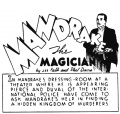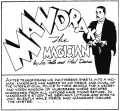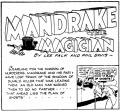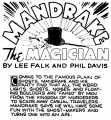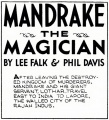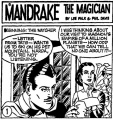Spotlight on Sunday strip layout: Difference between revisions
mNo edit summary |
m (moved Sunday strip layout to Spotlight on Sunday strip layout) |
Revision as of 15:06, 17 August 2013
The full page years
The early Mandrake Sunday strips filled an entire newspaper page. Phil Davis layout his first Sunday story with 4 strips a page before he started experimenting with different variants of layout. The various pages could have 2, 3 or 4 strips and some panels could span more than one row.
In the first Sunday story Phil Davis also experimented with the logo for the pages.
The first logo and variants for the Sunday pages
The second logo and variants for the Sunday pages
The third logo and variants for the Sunday pages
The full and half page years
Because of paper shortages during World War II some newspapers requested possibility to print the Mandrake Sunday strips on a half page. Phil Davis started to layout the pages so the numbered panels could be rearranged to fit both a full or half page. The last page made for full page only was at April 26, 1942. From the strip of March 22, 1959 the logo shrunk.
The full, half and third page years
To save the expense of printing so many color pages some newspapers requested possibility to print the Mandrake Sunday strips on a third page. The layout changed and one can find two common logos in this period.
Only the full and half format is complete and the third page dropping the top row from the half page. Such "throwaway" panels often contain material that is not vital to the main part of the strip.
The fourth logo and variants for the Sunday pages
The full, half, third page years II
Fred Fredericks was the new artist from the strip of July 27, 1965. Unlike Phil Davis drew his Sunday pages in the half page landscape format. The logo used for the half pages layput was similar to the one used on rearranged half pages by Phil Davis, except the text "by Lee Falk" vs "by Lee Falk and Phil Davis".
In the strip of June 6th 1970 the layout changed a bit and now we can see a larger logo made by Fred Fredericks.



